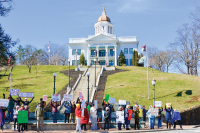Snowed in and booked up
“I never trusted happiness,” Robert Duvall says in “Tender Mercies.” I have begun to feel the same way about vacations.
Last summer, I planned to get away alone for five days in New York City. A bout of pneumonia put me into the hospital and left an empty seat on a north-bound aircraft.
This time everything was smooth as a slipstream on a windless day. My flight from the Greenville-Spartanburg Airport on the evening after Christmas arrived on time in Albuquerque, N.M. A red PT Cruiser that the rental car agency was holding for me cost me nearly double the amount quoted on the phone — they never tell you about the surcharges, and I bought some minimal insurance — but I was expecting such piracy and was unsurprised. The studio condominium in Santa Fe that a friend had arranged for me for $25 per night, an easy walk from the downtown where motels rented for $150 and up, was spacious and warm.
After waking early on Wednesday, I spent the day walking through Old Town, visiting Saint Francis Cathedral (on my way out, I passed eight pallbearers toting a large casket, possibly an omen but one which I ignored), and exploring expensive shops. I ordered brioche and coffee in the delightful Paris Café, and later completed some work in the local library.
Thursday took me north on Route 285 to the Sangre de Cristo Mountains and the community of Chimayo, where I visited the Santuario, or old church. Here I met the delightful Father Roca, delighted in the tacky folk art on the church walls, and attended mass. On my return through the mountains I resisted the gambling casinos along the highway, doubtless saving myself a good deal of money.
Related Items
Back in the Santa Fe Public Library, I found an e-mail from my editor, Sarah, requesting two book reviews by Jan. 11. She was soon to head off on a belated honeymoon. I felt confident I could read the books and write the reviews on my return home.
The snow began to fall just as I clicked off the library’s computer.
The snow fell the rest of that afternoon and through the night. It fell all day Friday and all Friday night. Now it is Saturday, and the snow is still falling. Officials have closed I-25 and I-40. The snow in the condominium parking lot comes well above my knees. I haven’t left the condo for more than 24 hours.
Such an abundance of time has caused me to cast about in search of books for review. The copies of Jane Eyre and the Aeneid in Latin that I brought with me — I teach both books — might do, but I have other resources at hand.
On Thursday evening my friend lent me a copy of Chiva: A Village Takes on the Global Heroin Trade (ISBN 0-86571-513-0, $15.95), Chellis Gendinning’s vivid account of how the bloody trade in chiva — the street name for heroin — has affected the mountain town of Chimayo, which I had visited that day, and how the citizens of Chimayo have begun to battle against the dealers and users who have so exploited their community.
Although Glendinning attempts to trace the international politics behind the heroin trade, her writing in this regard will strike many as chaotic and confused as the drug trade itself. She moves us from Burma to Germany to Colombia, from the streets of Chicago to the jungles of Latin America, with abrupt, jarring jumps that will leave even close readers scratching their heads. From her tangled descriptions we get a sense of terrible complexity of the international drug trade, but we must turn to other sources if we wish an intelligible account of this criminal market.
Where Glendinning does excel is in her personal take on Chimayo itself, a place of spirituality for a thousand years, a place of great natural beauty and ugly poverty, a haven for drug dealers, yes, but also a retreat center for devout Catholics. Glendinning, who lives in Chimayo, gives us a personal account of the gangsters who so abuse this town and of the citizens who are fighting against them. Her own fearlessness in publishing this book with its names and portraits of dealers and drug lords is highly commendable.
•••
Ever wonder what a trace is? A run? The difference between ruffles and a ripple on a river? Edited by Barry Lope and Debra Gwartney, Home Ground: Language for an American Landscape (ISBN 1-59534-024-6, $29.95) gathers together more than 850 geographical definitions in regard to the American landscape. Here we learn that a trace was a path established first by animals, then used by Native Americans, and finally taken up by pioneers and settlers. We learn that a run is an old name for nearly any kind of stream or creek (Bull Run). I will leave it to readers to find out the difference between ruffles and ripples.
Bringing these definitions to the page is a wide variety of American writers gathered together by Lopez and Gwartney. The editors had professional geographers check out the writers’ definitions, but as Barry Lopez tells us, “their (the writers) intent was to celebrate and inform, and to point us toward the greater body of work which they perused in their research ....”
Home Ground is one of those lovely books that tempts us again and again to quotation. A piece on the term trace, written by Alberto Urrea, is a fine example of the inclusion of history in this book, information that tempts us to explore beyond such brief accounts:
The Natchez Trace, running from Natchez, Mississippi, to Nashville, Tennessee, is prehistoric in origin. It was used as a walking route by Chickasaws and Choctaws until explorers, traders, and boat men made it the busiest highway in what was called the ‘Old Southwest’... For a time, outlaws attracted by trade made the Trace the most violent place in America. Meriwether Lewis committed suicide — or was murdered — at an isolated inn on the Natchez Trace.
Home Ground is one of those special books, a wonderful treasury of observations, that should appeal to nearly all readers.









